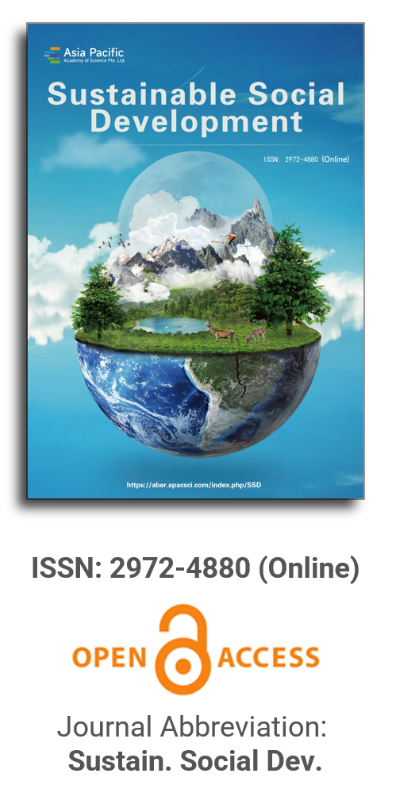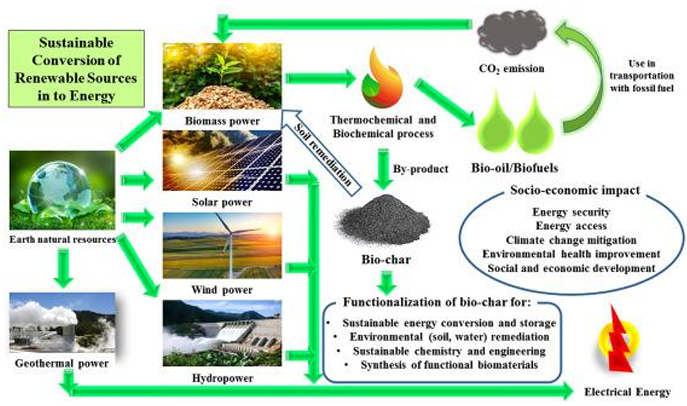
Asia Pacific Academy of Science Pte. Ltd. (APACSCI) specializes in international journal publishing. APACSCI adopts the open access publishing model and provides an important communication bridge for academic groups whose interest fields include engineering, technology, medicine, computer, mathematics, agriculture and forestry, and environment.

Geological and hydro-chemical characterisations of groundwater resources in the Wa municipal district
Vol 2, Issue 1, 2024
Download PDF
Abstract
Few studies go beyond one or two parameters of groundwater characterisation at a time. This paper uses a multifaceted approach to describe the nature of groundwater beyond water quality, including the physical, environmental, and practical aspects of groundwater prospecting, the health effects, and how these conform to expected standards in global and national contexts. This was achieved by exploring the geological and hydrochemical characterisations of groundwater in the Wa municipality of Ghana. The main objective was to describe the spatial, hydro-geological, and hydro-chemical characteristics of groundwater in the rural areas of the Wa municipality. Using a sequential exploratory mixed research design and a digital elevation model, this study found that groundwater constitutes the main source of safe drinking water for rural and peri-urban communities, geologically dominated by granite and sandstone aquifers. The average transmissivity was 8.88 m2/day, the average hydraulic conductivity was 0.18 m/day, the average aquifer thickness was 56.8 mbgl, and the average borehole water yield was 14.54 L/min. However, there were technological constraints on the ability to prospect water from confined aquifers at sites in the higher parts of the digital elevation model. Also, a lack of water quality tests for some boreholes results in the exposure of users to the effects of fluoride, causing dental fluorosis. The use of ultra-deep hand pump technologies, water quality testing of all boreholes, and artificial groundwater recharge methods for sustainable borehole water yield were recommended.
Keywords
References
- Lachassagne P. What is groundwater? How to manage and protect groundwater resources. Annals of Nutrition and Metabolism. 2020, 76(Suppl. 1): 17-24. doi: 10.1159/000515024
- National Geographic Society. Groundwater. Available online: https://education.nationalgeographic.org/resource/groundwater/ (accessed on 11 January 2024).
- Chaturvedi A, Pandey B, Yadav AK, Saroj S. An overview of the potential impacts of global climate change on water resources. In: Thokchom B, Qiu P, Singh P, Iyer PK (editors). Water Conservation in the Era of Global Climate Change. Elsevier; 2021. pp. 99–120. doi: 10.1016/b978-0-12-820200-5.00012-9
- Udegbunam S. Artificial groundwater recharge—exploratory guide. Available online: https://afrilcate.com/artificial-groundwater-recharge/ (accessed on 11 January 2024).
- de Graaf IEM, Gleeson T, (Rens) van Beek LPH, et al. Environmental flow limits to global groundwater pumping. Nature. 2019, 574(7776): 90-94. doi: 10.1038/s41586-019-1594-4
- O’Carroll DM. Nanotechnology for contaminated subsurface remediation. Nanotechnology applications for clean water. 2014. 441-456. doi: 10.1016/b978-1-4557-3116-9.00028-7
- United Nations Education, Scientific and Cultural Organisation (UNESCO). Groundwater uses and benefits. Available online: https://www.unesco.org/reports/wwdr/2022/en/benefits#:~:text=The%20ability%20of%20groundwater%20resources,supply%20systems%20are%20directly%20affected (accessed on 17 January 2024).
- Asante-Annor A, Ewusi A. hydrogeological properties of the rocks in Adansi mining area, Ghana. Ghana Mining Journal. 2016, 16(1): 31. doi: 10.4314/gmj.v16i1.4
- Gorai A, Kumar S. Spatial distribution analysis of groundwater quality index using GIS: a case study of Ranchi Municipal Corporation (RMC) area. Geoinformatics & Geostatistics: an overview. 2013, 01(02). doi: 10.4172/2327-4581.1000105
- Bodrud-Doza Md, Islam ARMT, Ahmed F, et al. Characterization of groundwater quality using water evaluation indices, multivariate statistics and geostatistics in central Bangladesh. Water Science. 2016, 30(1): 19-40. doi: 10.1016/j.wsj.2016.05.001
- Okofo LB, Bedu-Addo K, Martienssen M. Characterization of groundwater in the “Tamnean” plutonic suite aquifers using hydrogeochemical and multivariate statistical evidence: a study in the Garu-Tempane District, Upper East Region of Ghana. Applied Water Science. 2022, 12(2). doi: 10.1007/s13201-021-01559-2
- Manu E, De Lucia M, Kühn M. Hydrochemical characterisation of surface water and groundwater in the crystalline basement aquifer system in the Pra Basin (Ghana). Water. 2023, 15(7): 1325. doi: 10.3390/w15071325
- Oxford English Dictionary. Characterisation. Available online: https://www.oed.com/search/dictionary/?scope=Entries&q=Characterisation (accessed on 11 January 2024).
- Kanade V. What is spatial analysis? definition, working, and examples. Available online: https://www.spiceworks.com/tech/artificial-intelligence/articles/what-is-spatial-analysis/# (accessed on 11 January 2024).
- Lumen Learning. Reading: Groundwater. Available online: https://courses.lumenlearning.com/geo/chapter/reading-groundwater-2/ (accessed on 11 January 2024).
- Zhang B, Zhao D, Zhou P, et al. Hydrochemical characteristics of groundwater and dominant water–rock interactions in the Delinghaarea, Qaidam Basin, Northwest China. Water. 2020, 12(3): 836. doi: 10.3390/w12030836
- Kesse GO. The mineral and rock resources of Ghana. A. A. Balkema Publishers; 1985. 610 p.
- Agyemang VO. Geophysical investigation of groundwater potential and aquifer protective capability in selected communities within Cape Coast municipality, Ghana. Applied Water Science. 2022, 12(2). doi: 10.1007/s13201-021-01558-3
- Poeter E, Fan Y, Cherry J, et al. Groundwater in Our Water Cycle: Getting to Know Earth’s Most Important Fresh Water Source. The Groundwater Project; 2020. 136p. doi: 10.21083/978-1-7770541-1-3
- Water Science School. Surface runoff and the water cycle. Available online: https://www.usgs.gov/special-topics/water-science-school/science/surface-runoff-and-water-cycle (accessed on 11 January 2024).
- United States Geological Survey. Unsaturated zone. Available online: https://water.usgs.gov/ogw/unsaturated.html(accessed on 11 January 2024).
- Wang C, Zhu A, Liao X, et al. Capillary effects on groundwater response to earth tides. Water Resources Research. 2019, 55(8): 6886-6895. doi: 10.1029/2019wr025166
- Margat J, van der Gun J. Ground Water Around the World: A Geographic Synopsis, 1st ed. CRC Press; 2013. doi: 10.1201/b13977
- International Association of Hydrologists. What is hydrology and what do hydrologists do? Available online: https://iah.org/education/general-public/what-ishydrogeology#:~:text=Hydrogeology%20is%20the%20study%20of,and%20rock%20(the%2 0geology) (accessed on 11 January 2024).
- Tetteh F, Larbi A, Nketia KA, et al. Suitability of soils for cereal cropping in northern Ghana. Available online: https://cgspace.cgiar.org/server/api/core/bitstreams/f9c268ba-3146-43dd-925e-450a7657d06a/content (accessed on 23 January 2024).
- Fityus SG, Smith DW. The development of a residual soil profile from a mudstone in a temperate climate. Engineering Geology. 2004, 74(1-2): 39-56. doi: 10.1016/j.enggeo.2004.02.001
- Schoonover JE, Crim JF. An introduction to soil concepts and the role of soils in watershed management. Journal of Contemporary Water Research & Education. 2015, 154(1): 21-47. doi: 10.1111/j.1936-704x.2015.03186.x
- Rogers D, Powell M, Ebert K. The link between groundwater and surface water. Available online: https://eupdate.agronomy.ksu.edu/article_new/the-link-between-groundwater-and-surface-water-535-3 (accessed on 11 January 2024).
- Schloss JA, Buddemeier RW. Current saturated thickness. Available online: https://www.kgs.ku.edu/HighPlains/atlas/atcst.htm (accessed on 11 January 2024).
- Şen Z. Practical and Applied Hydrology. Elsevier; 2015. doi: 10.1016/C2013-0-14020-2
- Department of Natural Resources and Environment Tasmania. Confined and unconfined aquifers. Available online: https://nre.tas.gov.au/water/groundwater/aquifers/confined-unconfined-aquifers (accessed on 11 January 2024).
- Van der Gun J. Large Aquifer Systems around the World. The Groundwater Project; 2022. doi: 10.21083/978-1-77470-020-4
- Water Resources Mission Area. Sandstone aquifers. Available online: https://www.usgs.gov/mission-areas/water-resources/science/sandstone-aquifers (accessed on 23 January 2024).
- Community Water and Sanitation Agency. Upper west region. Available online: https://www.cwsa.gov.gh/upper-west-region-3/ (accessed on 23 January 2024).
- Huang F, Zhang Y, Zhang D, et al. Environmental groundwater depth for groundwater-dependent terrestrial ecosystems in arid/semiarid regions: a review. International Journal of Environmental Research and Public Health. 2019, 16(5): 763. doi: 10.3390/ijerph16050763
- Green DL, Petrovic J, Burrell M, Moss P. Water resources and management overview: Gwydir River catchment. North South Wales Office of Water; 2011.
- Kyere CA, NoyeR M, Menyeh A. Prospecting for groundwater in the Bawku West District of the Upper East Region of Ghana using the electromagnetic and vertical electrical sounding methods. Journal of Ghana Science Association. 2013, 15(1): 68-78.
- Rural Water Supply Network. Implementation-handpump technology: other handpumps. Available online: https://www.rural-water-supply.net/en/implementation/proprietary-handpumps/other-handpumps (accessed on 17 January 2024).
- Gouldburn-Murray Water. Groundwater terms and definitions. Available online: https://www.g-mwater.com.au/downloads/gmw/Groundwater/29012016-_2977263-v9-GROUNDWATER_TERMS_AND_DEFINITIONS_GLOSSARY_FOR_USERS.pdf (accessed on 17 January 2024).
- Bukari FBM, Aabeyir R. Assessment of water security threats in Wa municipality, Bongo and Bawku West Districts. WaterAid Ghana Report; 2022.
- Sudheer Kumar M, Srinivas Chary R, Srinivasa Reddy K, Mondal NC. Evaluation of hydrogeological properties of fractured granitic aquifer in a micro watershed of Kandukuru Southern India Sandstone. International Journal of Water Resources and Environmental Engineering. 2012, 4(12): 386-396. doi: 10.5897/IJWREE12.047
- Akanbi OA. Hydrogeological characterisation and prospect of basement aquifers of Ibarapa region, southwestern Nigeria. Applied Water Science. 2018, 8(3). doi: 10.1007/s13201-018-0731-9
- El-Rawy M, De Smedt F. Estimation and mapping of the transmissivity of the Nubian sandstone aquifer in the Kharga Oasis, Egypt. Water. 2020, 12(2): 604. doi: 10.3390/w12020604
- Al-Sudani HIZ. Groundwater system of Dibdibba sandstone aquifer in south of Iraq. Applied Water Science. 2019, 9(4). doi: 10.1007/s13201-019-0952-6
- Ofomola MO, Otheremu OP, Ohwoghere‑Asuma O, et al. Determination of aquifer hydraulic characteristics from surface electrical and borehole measurements in Ozoro, Nigeria. Nigerian Journal of Technological Development. 2022, 19(3): 240-249. doi: 10.4314/njtd.v19i3.6
- Living Water Technologies. Our services: choosing the right systems for your home. Available online: http://livingwaterstechnologies.co.za/services.html (accessed on 11 January 2024).
- Cobbing J. WaterAid Multi-Country Research on Water Security: HSBC Water Programme: Global Synthesis Report. WaterAid; 2020.
- Creswell JW. Research Design: Qualitative, Quantitative, and Mixed Methods Approaches, 4th ed. Sage Publications; 2013.
- Alvi MH. A manual for selecting sampling techniques in research. Available online: https://mpra.ub.uni-muenchen.de/70218/ (accessed on 23 January 2024).
- Ghana Statistical Service. District Analytical Report: Wa Municipal. Ghana Statistical Service; 2014.
- Michigan Technological University. Hydrology/water resources. Available online: https://www.mtu.edu/cege/undergraduate/advising/pdfs/fe-reviewnotes-hydrogeology-jsgierke-30dec2013.pdf (accessed on 26 January 2024).
- Louisiana Department of Environmental Quality. Appendix F: Aquifer tests. Available online: https://www.deq.louisiana.gov/assets/docs/Land/RECAP/APPENDIXF.pdf (accessed on 26 January 2024).
- Auriga Research. Types of water testing & how to test water. Available online: https://aurigaresearch.com/water-testing/types-of-water-testing/ (accessed on 17 January 2024).
- Food and Agricultural Organisation. Ghana: Regional Water Report. Food and Agricultural Organisation; 2005.
- Rural Water Supply Network. Other handpumps. Available online: https://www.rural-water-supply.net/en/implementation/proprietary-handpumps/other-handpumps (accessed on 23 January 2024).
- Tse AC, Amadi PA. Hydraulic properties from pumping tests data of aquifers in Azarearea, North Eastern Nigeria. Journal of Applied Science and Environmental Management. 2008, 12(14): 67-72. doi: 10.4314/jasem.v11i4.55198
- Akinwumiju AS, Olorunfemi MO. Shallow aquifer characteristics, borehole yield and groundwater resource sustainability assessment in the Osun drainage basin, southwestern Nigeria. Ife Journal of Science. 2016, 18(2): 305-314.
- Scherrer C, Schweitzer R, BünzliM, Milnes E. Rapid groundwater potential mapping in humanitarian contexts: improving borehole implementation in basement environments. Hydrogeol Journal. 2021, 29: 2033-2051. doi: 10.1007/s10040- 021-02352-w
- Akinlalu AA, Afolabi DO. Borehole depth determination to freshwater and well design using geophysical logs in coastal regions of Lagos, Southwestern Nigeria. Applied Water Science. 2018, 8: 152. doi:10.1007/s13201-018-0798-3
- El Janyani S, Dupont JP, Massei N, et al. Hydrological role of karst in the chalk aquifer of Upper Normandy, France. Hydrogeology Journal. 2014, 22(3): 663-677. doi: 10.1007/s10040-013-1083-z
- Condon LE, Maxwell RM. Evaluating the relationship between topography and groundwater using outputs from a continental-scale integrated hydrology model. Water Resources Research. 2015, 51(8): 6602-6621. doi: 10.1002/2014WR016774
- Clearwater Pumps. Borehole yield testing. Available online: https://clearwaterpumps.co.za/borehole-yield-testing/ (accessed on 23 January 2024).
- World Health Organisation. Protecting Groundwater for Health: Managing the Quality of Drinking Water Sources. IWA Publishing; 2016.
- Taonameso S, Mudau LS, Traoré AN, et al. Borehole water: A potential health risk to rural communities in South Africa. Water Supply. 2018, 19(1): 128-136. doi: 10.2166/ws.2018.030
Supporting Agencies
Copyright (c) 2024 Francis Issahaku Malongza Bukari, Shamsu-Deen Ziblim, Raymond Aabeyir
License URL: https://creativecommons.org/licenses/by/4.0

This site is licensed under a Creative Commons Attribution 4.0 International License (CC BY 4.0).

Prof. Kittisak Jermsittiparsert
University of City Island, Cyprus






It is with deep regret that we announce the cancellation of the Forum on Sustainable Social Development & Computing and Artificial Intelligence, originally scheduled for June 15, 2025.

